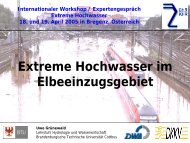ABSTRACTS 'Extreme Discharges' - CHR-KHR
ABSTRACTS 'Extreme Discharges' - CHR-KHR
ABSTRACTS 'Extreme Discharges' - CHR-KHR
You also want an ePaper? Increase the reach of your titles
YUMPU automatically turns print PDFs into web optimized ePapers that Google loves.
Impact assessment of flood mitigation measures<br />
Matthijs Kok<br />
HKV Consultants, the Netherlands<br />
P.O. Box 2120, NL 8203 AC Lelystad, the Netherlands<br />
m.kok@hkv.nl<br />
Assessing impacts of flood mitigation measures (such as dike strengtening, lowering flood plains, building watertight<br />
compartments, retention areas and spatial planning) can be done with traditional cost/benefit methods.<br />
These methods are in decision making for two reasons not sufficient. First, flooding does also influence<br />
“goods’ having not only a purely economical value, such as human lives, cultural goods and the value of keeping<br />
control of the situation. Second, measures do not have only economic costs, but may provide other noneconomical<br />
costs and benefits. Examples are the impacts on landscape of dike strenthening (see for example<br />
Walker et al, 1994) or the increase of nature values by lowering the flood plains. However, in this presentation<br />
we concentrate ourselves on the economic approach. In this approach the expected yearly risk is calculated,<br />
where risk is defined as the product of the probability of flooding and the economic damage of a flood. Assessing<br />
these probabilities is not easy, because there are many failure mechanisms and many dike sections (and<br />
structures). For an adequate assessment these factors have to be taken into account. Assessing flood damage is<br />
often done by assuming a ‘flood scenario’, calculating flood depths. These depths are combined with damage<br />
functions, which give the relation between depth and damage. Next, the Present Value of the expected yearly<br />
risk is calculated to assess the total benefits, taking into account economic growth and sometimes also climate<br />
change is included. Incorporation of economic growth and climate change changes the problem into a dynamic<br />
investment problem, as already described by Van Dantzig (1956). Repeated investments in flood mitigation<br />
measures are necessary from an economical point of view.<br />
In the presentation we will discuss three new methodological developments in the economical impact assessment<br />
of flood mitigation measures. First, the relation between the exceedance frequency of water levels (which<br />
is often used as the indicator of flood probability) and the flood probability will be discussed using some examples.<br />
In the examples we will not consider all failure mechanisms, but only the mechnism ‘overflow and wave<br />
overtopping’. In this example we consider the natural variability of water levels, but also knowledge uncertainties.<br />
Second, the approach of Van Dantzig is recently extended by Eijgenraam (2003), and we will present the<br />
consequences of his approach. In his approach, the ‘optimal’ protection level decreases in time (safety will increase),<br />
due to economic growth. And by climate change the flood probability increases, and additional investments<br />
are neceassary from an economical point of view. Thirdly, assessment of flood damages has a lot of uncertainties,<br />
and we present results of an uncertainty analysis of flood damage using, carried out by HKV Consultants<br />
and Delft University of Technology.<br />
Literature<br />
Dantzig, D. van., 1956. Economic decision problems for Flood prevention. Econometrica, 1956.<br />
Eijgenraam, C.J.J. “KBA Ruimte voor de Rivier. Hoogte van dijken”, Centraal Plan Bureau, Memorandum,<br />
6 september 2004.<br />
Walker, W., M. Kok et al., 1994. A Policy Analysis of Dutch River Dike Improvements: trading off Safety, Cost,<br />
and Environmental Impacts. Operations Research 42, 5, 823-836, 1994.<br />
53





